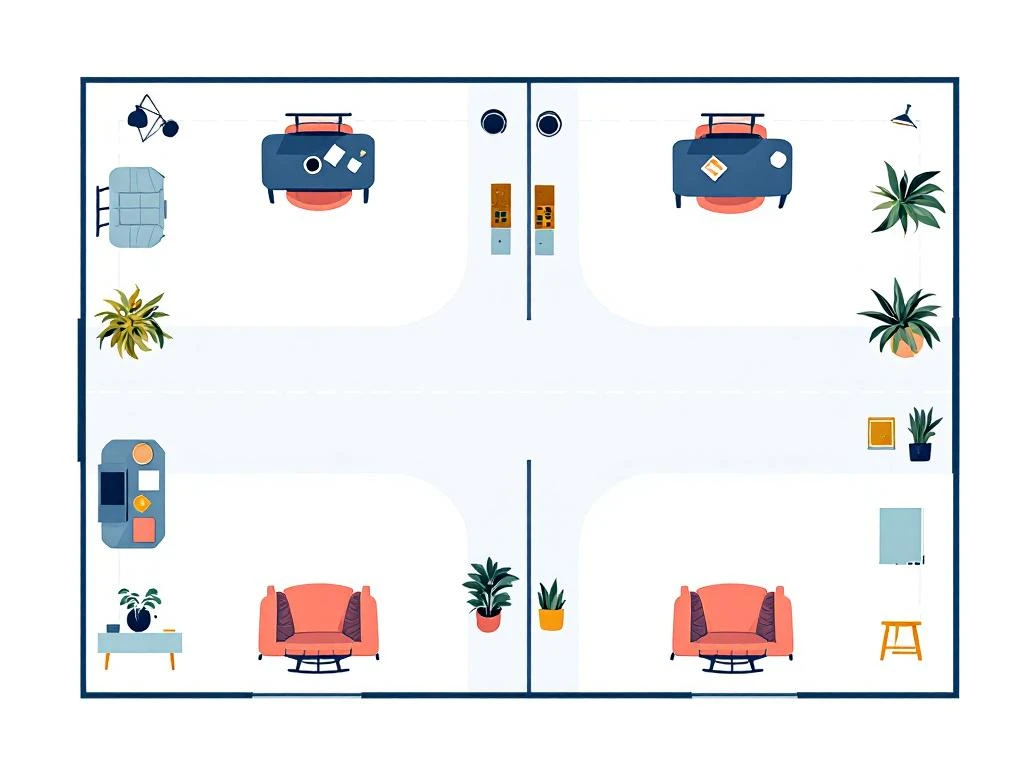An office for 4 people ideally needs at least 40-60 m² to work comfortably and productively. According to Dutch Occupational Health and Safety guidelines, the minimum space per workstation is about 8-10 m², including the desk, chair and sufficient space for movement. For a team of 4, this means a minimum of 32-40 m² just for the workstations. Add to that space for circulation, storage, and possibly a small meeting room, and you quickly arrive at 50-60 m². Of course, the exact dimensions depend on the type of work, equipment needed, and additional amenities desired.
How big should an office be for 4 people?
An office for 4 people should be at least 40-60 m² for a functional workspace. Dutch occupational health and safety guidelines recommend 8-10 m² per workstation as minimum area. This means that for just the workstations, you need 32-40 sq. ft.
This calculation includes the base space for:
- Workstation with desk and chair (minimum 7 sq. ft. per person)
- Movement space around the workplace
- Walkways between workstations
For an optimal office experience, it is wise to reserve extra space in addition to the minimum area. Indeed, an office that is too cramped can lead to reduced productivity, privacy issues and a less pleasant working environment. A guideline of 12-15 sq. ft. per person provides a comfortable workspace including additional facilities such as a small meeting room or pantry.
What are the minimum dimensions per workstation according to occupational health and safety standards?
According to Dutch Arbo standards, each workplace must have a minimum of 7 m² of surface area, with an additional 1-3 m² for movement space. This means a total of 8-10 m² per person if legal minimum. These standards are set forth in the Working Conditions Decree.
The specific minimum requirements per workplace are:
- Minimum 7 sq. m. of floor space for the workplace itself
- At least 1.8 meters clear height above the workplace
- At least 3.5 m² of free movement space around the workstation
- A desk table at least 120 cm wide and 80 cm deep
- Adequate walking space between workstations (at least 60-80 cm)
In addition to these minimum dimensions, the Occupational Health and Safety Act also sets requirements for lighting, climate control and ergonomics. A good office space not only meets the minimum requirements, but also provides a healthy and pleasant working environment that allows for long-term productive work.
How do you efficiently set up an office of 4 people?
You set up an office for 4 people efficiently by using smart workplace design combine with functional common areas. Start by determining the right desk setup that fits the team's work style.
Effective desk setups for 4 people are:
- Island arrangement: 4 desks placed in a square, promoting collaboration
- Parallel arrangement: 2 rows of 2 desks, allowing more individual focus
- L-shaped arrangement: desks along two adjacent walls, which keeps the central space clear
When decorating, consider walkways at least 80 cm wide. Place cabinets and storage against the walls to keep the central space clear. Consider a shared printing and storage station that is easily accessible to everyone without being in the way.
An efficient layout also takes into account cable management. Choose desks with integrated cable trays and use cable clips or channels to neatly hide cords. This prevents tripping hazards and gives the office a tidy look.
What spaces do you need besides workstations?
In addition to the direct workstations, for a complete office of 4, you also need additional spaces. The most important support rooms are:
- A small meeting room or consultation corner (8-12 sq. ft.) for internal discussions and client calls
- A pantry or coffee corner (4-6 m²) for breaks and informal conversations
- Storage or archive space (3-5 sq. m.) for office supplies and documents
- A wardrobe or coat rack area (2-3 sq. m.) for coats and personal belongings
For a team of 4, a combined space can often be more efficient than separate rooms. For example, a multipurpose corner can serve as both a meeting room and lunch area. This saves space without sacrificing functionality.
If clients or outside visitors come regularly, also consider a small reception area. This need not be large - a small sitting area with 2-3 chairs at the entrance may be sufficient. In a office space where space is limited, multifunctional use of spaces is the key to efficiency.
What are the advantages of a more spacious office versus minimal space?
A more spacious office offers significant advantages over minimal space, particularly in terms of work performance and well-being. In a more spacious office, employees experience less stress, more privacy and higher satisfaction with their work environment.
Benefits of a more spacious office:
- Improved concentration through reduced noise and visual distractions
- More freedom of movement which contributes to physical well-being
- Flexibility for future expansion or redesign
- Space for informal meetings and creative collaboration
- Better air quality and climate control
With minimal office space, consider potential drawbacks such as reduced privacy, increased mutual interference and a sense of restriction. This can lead to increased stress and decreased productivity, especially in tasks that require concentration.
The ideal balance often lies with an office that is spacious enough for comfort, but not so large that it becomes impersonal or overly costly. For a team of 4, a 60-80 sq. ft. office often provides this optimal balance.
How does the type of work affect the office space required?
The type of work your team performs directly affects how much office space you need. Different work activities make different demands on the working environment and required surface area.
Creative work and design often require more space (15-20 sq. ft. per person) because of:
- Larger worksheets for sketches and materials
- Space for inspiration boards and visual aids
- Need for informal consultation spaces for brainstorming sessions
For administrative or computer-based work, the space can be more compact (10-12 sq. ft. per person) because:
- Standard desks are usually sufficient
- Fewer physical materials are needed
- Digital communication plays a greater role than face-to-face consultations
Teams that make a lot of phone or video calls benefit from additional space or separate cubicles to reduce noise. In an office with a lot of customer contact, a presentable conference room is essential.
The balance between individual work and team work also plays a role. Teams that work closely together benefit more from an open office layout, while work that requires a lot of concentration benefits more from screened-off workstations.
What are flexible alternatives if you don't have enough space?
If you don't have enough space for a full 4-person office, there are several flexible solutions that can offer solutions. These alternatives will help you use limited space efficiently.
- Hybrid work model: combine working from home with office days so that not everyone has to be physically present at the same time
- Flexible workstations: set up fewer workstations than the number of employees and work with a rotation system
- Coworking spaces: rent workspaces in a shared workspace where facilities such as meeting rooms are already in place
- Satellite offices: divide the team among several smaller locations, possibly closer to where they live
- Multi-purpose rooms: use the same space for different purposes (for example, a meeting room that serves as a workspace outside of meetings)
Modern technology makes it easier than ever for teams to work dispersed without compromising communication and collaboration. Tools for video conferencing, project management and file sharing enable effective remote collaboration.
Flexible office solutions not only offer space savings, but can also contribute to a better work-life balance for employees and lower housing costs for the company.
What should you remember when choosing an office for 4 people?
When choosing an office for 4, there are some key points to keep in mind. First of all, you must meet the minimum Occupational Health and Safety requirements of 8-10 sq. ft. per person, which amounts to at least 32-40 sq. ft. for workstations alone.
In addition, keep in mind:
- The nature of the work and specific space needs of your team
- Need for additional spaces such as meeting rooms and break rooms
- Growth potential of your team in the near future
- Balancing privacy and collaboration in office setup
- Natural light, climate control and acoustics for a pleasant working environment
A good office is more than just enough square footage - it's about a space that supports productivity, well-being and team culture. So invest in thoughtful design with ergonomic furniture and a logical workflow.
If finding the right office space remains a challenge, flexible office solutions are worth considering. These offer the benefits of a professional work environment without long-term commitments. Want to learn more about how we can help you find the perfect workspace for your team of 4? Then feel free to contact with us.

